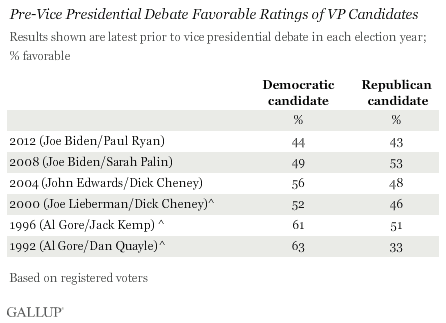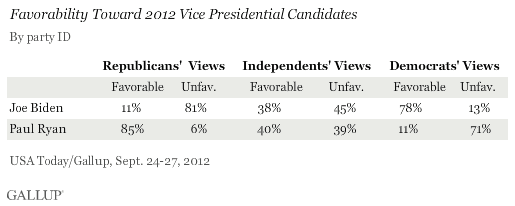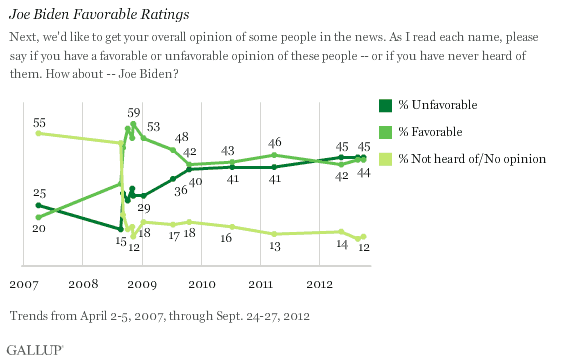PRINCETON, NJ -- Americans view Vice President Joe Biden and Republican vice presidential nominee Paul Ryan similarly heading into Thursday's vice presidential debate, with 44% viewing Biden and 43% viewing Ryan favorably. This contrasts with most other vice presidential pairings since 1992 when one candidate had higher favorable ratings than the other in advance of the election's vice presidential debate.

At 44%, Biden has the lowest pre-debate favorable rating of any Democratic vice presidential candidate of the past six elections. At 43%, Ryan's favorable score is no better, but he is viewed more positively than Vice President Quayle was in 1992 and roughly on par with Cheney in 2000. Both of those candidates were associated with Republican tickets that lost the popular vote (although, in the case of Bush/Cheney, not the Electoral College).
Al Gore was easily the most popular vice presidential candidate of the last two decades. More than six in 10 Americans viewed him favorably prior to the 1996 and 1992 vice presidential debates, eclipsing both of his opponents' favorable scores: Jack Kemp's 51% and Dan Quayle's 33%. John Edwards was viewed significantly better than Dick Cheney in 2004. Also, Joe Lieberman in 2000 and Sarah Palin in 2008 had slim favorability advantages over their counterparts.
Biden's Image Tilts Negative Among Independents
Despite the similarity in Biden's and Ryan's overall favorable ratings, Ryan may have a slight advantage in appealing to independents in the debate. According to the Sept. 24-27 USA Today/Gallup poll, independents have a more negative than positive view of Biden, by 45% to 38%, whereas they are evenly divided in their views of Ryan.
Ryan is also viewed more favorably by Republicans than Biden is by Democrats (85% vs. 78%), and at the same time is viewed less unfavorably than Biden by the opposing party (71% vs. 81%).

Biden's Ratings Steady for Three Years
Public opinion of Biden is decidedly mixed, with 44% viewing him favorably and 45% unfavorably. While this favorable rating is not stellar, it has been steady at this level for much of Barack Obama's presidency. Only in late 2008 and 2009 was it significantly higher, likely reflecting the surge in popularity for Obama around the time of his election and inauguration.
Biden's favorable rating has typically trailed Obama's by about 10 percentage points; so in late 2009, when Obama's favorable rating fell from the 60s into the 50s, Biden's fell from the 50s into the 40s, and has since remained there.

As Familiarity With Ryan Grows, He Gains Fans and Detractors
Ryan's image is also mixed, although, in contrast to Biden's image, slightly more view Ryan favorably than unfavorably, 43% vs. 40%. Roughly six in 10 Americans had no opinion of Ryan when Mitt Romney first tapped him as his running mate in mid-August. Negative views of Ryan initially grew more sharply than positive views. However, since the Republican National Convention, Ryan's favorable and unfavorable scores each increased by a consistent four to five percentage points.

Bottom Line
Biden and Ryan will take the stage in Danville, Ky., on Thursday about equally well-liked by Americans. Gallup trends suggest that past vice presidential debates have had little to no impact on voter preferences; nevertheless, the current parity between Biden and Ryan theoretically gives them equal opportunity to use the debate to their team's advantage, something Biden may be particularly focused on given Obama's subpar performance in the first presidential debate. However, demonstrating that pre-existing views are not determinative, Obama entered that debate with a 55% to 47% advantage over Romney in favorability, and yet, by 72% to 20%, debate viewers said Romney rather than Obama did the better job.
How much vice presidential popularity matters to the outcome of presidential elections is another question. The ticket with the more popular vice presidential candidate at the end of the campaign won in 1992, 1996, and 2008. However, George W. Bush won re-election in 2004, and roughly tied Al Gore in the popular vote in 2000 despite Cheney's favorability deficits to Edwards and Lieberman, respectively.
Survey Methods
Results for this USA Today/Gallup poll are based on telephone interviews conducted Sept. 24-27, 2012, with a random sample of 1,446 adults, aged 18 and older, living in all 50 U.S. states and the District of Columbia.
For results based on the total sample of national adults, one can say with 95% confidence that the maximum margin of sampling error is ±3 percentage points.
Interviews are conducted with respondents on landline telephones and cellular phones, with interviews conducted in Spanish for respondents who are primarily Spanish-speaking. Each sample includes a minimum quota of 400 cell phone respondents and 600 landline respondents per 1,000 national adults, with additional minimum quotas among landline respondents by region. Landline telephone numbers are chosen at random among listed telephone numbers. Cell phone numbers are selected using random-digit-dial methods. Landline respondents are chosen at random within each household on the basis of which member had the most recent birthday.
Samples are weighted by gender, age, race, Hispanic ethnicity, education, region, adults in the household, and phone status (cell phone only/landline only/both, cell phone mostly, and having an unlisted landline number). Demographic weighting targets are based on the March 2011 Current Population Survey figures for the aged 18 and older non-institutionalized population living in U.S. telephone households. All reported margins of sampling error include the computed design effects for weighting and sample design.
In addition to sampling error, question wording and practical difficulties in conducting surveys can introduce error or bias into the findings of public opinion polls.
View methodology, full question results, and trend data.
For more details on Gallup's polling methodology, visit www.gallup.com.
